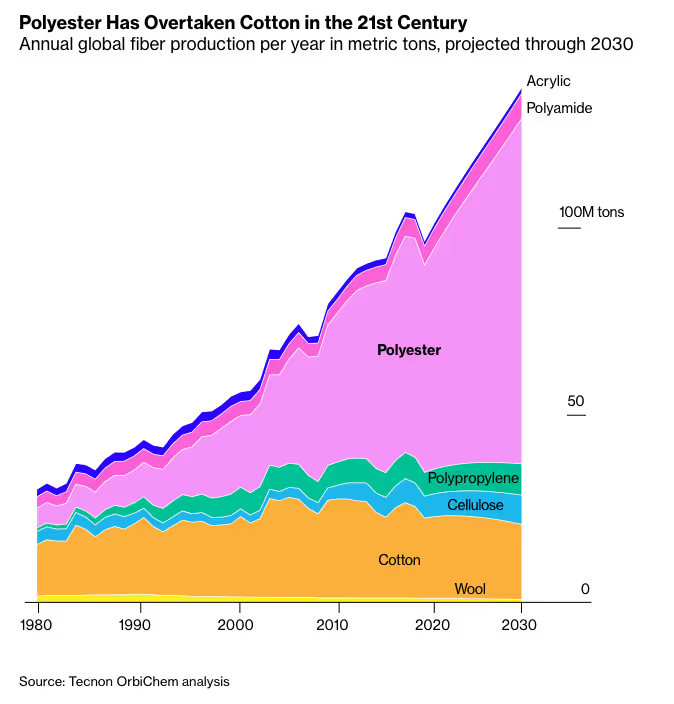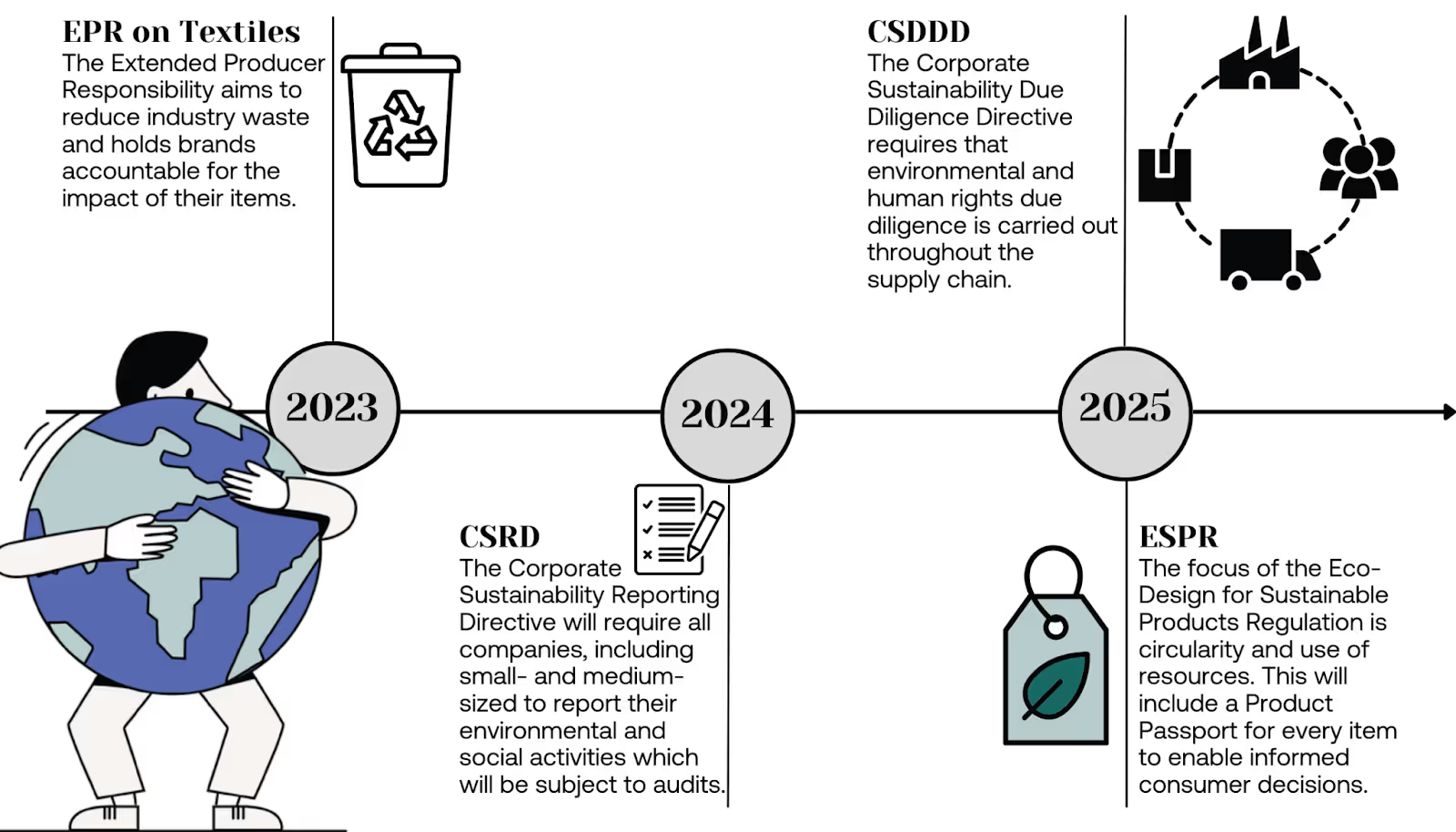The fashion industry substantially impacts climate change, from influencing CO2 levels to posing broader environmental threats. With approximately 4-8% of global greenhouse gas (GHG) emissions being attributed to the apparel and footwear industry, widespread concern exists about the industry's impact on climate change. Meanwhile, the extent to which the fashion industry is intertwined with human rights issues, such as fair wage payment, is increasingly being questioned.
The environmental and social impact of fashion
Unsustainable ‘fast-fashion’ trends have further accentuated the fashion industry's carbon footprint. Fast fashion promotes excessive consumption and a short-spanned life cycle of clothing, which leads to the mass production of low-priced clothing. The number of garments produced annually has doubled since 2000, and the industry has grown to account for a fifth of annual plastic production globally.
Meanwhile, fast fashion accelerates microplastics, energy, and water consumption, thus accentuating non-renewable resource dependence and climate change. Polyester—a ubiquitous form of plastic derived from oil—has overtaken cotton as the backbone of textile production. Garments made from polyester and other synthetic fibres are a prime source of microplastic pollution, especially harmful to marine life.
Finally, the environmental risks of fast fashion and its contribution to climate change are underlined by projections showing that the production of fossil fuel-based clothing will continue to grow in the next two decades.

Credit: Tecnon OrbiChem
Meanwhile, increasing social awareness around the destructive effects of fast fashion has underpinned a shift towards individuals placing a greater emphasis on sustainability when making decisions related to fashion. This involves considering the environmental footprint associated with garments, such as ensuring textile usage does not include microplastics, steering away from polyester, which depends on oil, ensuring garments are made to last, and ensuring the production of items does not require excessive energy or water usage.
Furthermore, there have been growing considerations of social factors, such as whether fair labour practices were used in the production of garments. The growing focus on sustainability in the fashion industry can be exemplified by Patagonia, which has committed to using 98% recycled materials, organic cotton, or other sustainable fabrics in its products.
However, fast fashion remains a prominent trend within the consumer market, causing widespread environmental destruction. This ultimately raises the question of:
- What regulations will be actioned to shape a low-carbon fashion economy?
- What will such regulations mean for fashion businesses around the globe?
Which ESG regulations are set to influence the fashion industry?
The inevitable acceleration of climate change and environmental damage associated with unsustainable fashion necessitates the implementation of policies and regulations that pave the way towards a more sustainable fashion industry.
Meanwhile, ensuring that the fashion industry is socially responsible requires laws that ensure workers are not subject to exploitation. As such, several new ESG regulations have been proposed globally in response to increased attention surrounding ESG and fashion.
Within the European Union (EU)

Credit: Plan A
- Extended Producer Responsibility on Textiles: The Extended Producer Responsibility (EPR) regulations aim to reduce industry waste and hold brands accountable for their items' environmental impact.
- Corporate Sustainability Due Diligence Directive: The Corporate Sustainability Due Diligence Directive (CSDDD) ensures that environmental and human rights due diligence are enacted across the whole supply chain of businesses.
- Corporate Sustainability Reporting Directive: The Corporate Sustainability Reporting Directive (CSRD) mandates that businesses of all sizes report their environmental and social activities, which are then subject to audits.
- Eco-Design for Sustainable Products Regulation: The Eco-Design for Sustainable Products Regulation (ESPR) aims to maximise sustainability by focusing on resource use, repairs and circularity. This regulation mandates that a ‘Product Passport’ be included with items to ensure consumers can make informed decisions.

Credit: Bloomberg
Such actioned and proposed regulations within the EU inevitably mean that greenwashing will no longer be an option for fashion businesses. The EU’s holistic strategy will transform how clothing is produced, distributed, and disposed of, thus paving the way to a circular and more sustainable fashion industry.
Within the United States (US)
ESG regulations have recently been introduced in the United States, aiming to shape a more sustainable fashion industry.
- Fashion Sustainability and Social Accountability Act: This proposed legislation focuses on larger companies and mandates that fashion companies map their supply chains whilst addressing their operations' broader environmental and social impacts.
- Fashioning Accountability and Building Real Institutional Change Act (FABRIC Act): The FABRIC Act is federal legislation that protects US textiles and fashion industry workers through fair working conditions, fair pay and safe working conditions.
- Garment Worker Protection Act: The Garment Worker Protection Act is a landmark step towards ending worker exploitation and ensuring fair pay within the fashion industry. The act works to incentivise brands through legal liability to tackle workplace violations and also eliminate the by-the-piece payment used to underpay workers
5 steps fashion companies must take to improve their ESG performance and reporting
The resource-intensive and wasteful nature of the textile sector ultimately makes it one of the least sustainable industries globally. With the production of textiles doubling between 2000 and 2015 - and expected to double by 2030 - the introduction of such ESG legislation is critical to provoking a genuine shift away from fast fashion trends, and paving a more sustainable fashion industry.
Whilst these regulations will aid in the industry’s transition towards sustainability, fashion-oriented businesses must take it upon themselves to reshape or improve their current business models by implementing sustainable policies and practices.
For fashion businesses to mitigate the detrimental effects of climate change and bolster their ESG performance to meet growing regulatory requirements - they must:
1. Utilise sustainability software
Leverage the vast opportunities and benefits associated with sustainability software. Plan A’s comprehensive sustainability platform takes a holistic approach to ensure businesses within the fashion industry can mitigate the non-financial and financial risks that will inevitably increase with forthcoming policy implementation.
In fact, studies are showing that high to severe ESG incidents lead to a 6% loss of market capitalisation on average. Furthermore, sustainability software can improve ESG performance to ensure businesses within the fashion sector can harness the long-term benefits of sustainability.

Credit: Plan A
2. Map out your supply chain
Supply chain analysis allows businesses within the fashion industry to identify any ESG risks or opportunities, such as incentivising key areas of the wider supply chain to utilise green energy. A beneficial component embedded within Plan A’s carbon management software is a suppliers module, which allows businesses to map out their supply chain and identify key opportunities and risks related to sustainability.
3. Undergo a life cycle analysis
A life cycle analysis (LCA) is a valuable scientific environmental impact assessment method that allows fashion businesses to measure the footprint of their products. A life cycle assessment assesses the environmental impact of a product throughout every phase of the product life cycle.
This includes analysing the environmental footprint across every stage, such as the production of raw materials, the production processes at a manufacturer, the transportation of materials and the product to consumers, the use of the product, and how a product is disposed of- or recycled.
4. Implement more circular practices
Following a life cycle analysis, fashion businesses must prioritise implementing circular practices - with a key focus on reusing and recycling. For instance, fashion businesses may take action to use fewer materials when producing individual items - thus increasing their recyclability.
Fashion businesses should also eliminate non-recyclable materials and pollutants from their supply chain. Lastly, fashion businesses should consider recapturing all unused materials for reuse, such as garment offcuts and packaging.
5. Use more sustainable packaging
Growing consumer awareness surrounding the detrimental environmental harm that single-use plastics cause has resulted in 72% of consumers being willing to pay more for a product that is packaged sustainably.
Meanwhile, the European Union’s ban on single-use plastic packaging means it is vital for fashion businesses to integrate sustainable packaging alternatives into their value chain. The Sustainable Packaging Coalition offers criteria for sustainable packaging that fashion businesses should follow.
The fashion industry’s substantial impact on climate change, from influencing CO2 levels to posing broader environmental threats, ultimately necessitates businesses to reshape their practices to reduce their carbon footprint and ensure compliance with new policies and regulations within the fashion sector.
By following the steps above, fashion-oriented companies will ensure they comply with policies whilst being transparent with internal and external stakeholders, thus enabling them to unlock long-term strategic value through sustainability.
Book a demo with Plan A to ensure compliance with upcoming ESG regulations and realise the benefits of implementing sustainability within your business.



.jpg)





